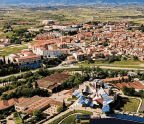
Spätburgunder is the German name for Pinot Noir, and means literally ‘late Burgundy’, in reference to its ripening time and origin. It is possible that the variety first arrived in Germany as early as the ninth century. An often-cited story recounts how Charlemagne [d. 814 AD] ordered monks to plant a vineyard in the Rheingau, on a hill below what is now known as Schloss Johannisberg. It may well be Pinot Noir that they planted, as wild Pinot grapes have been found growing on a nearby island in the Rhine.
As Benjamin Lewin MW points out in his comprehensive study In Search of Pinot Noir (Vendange, 2011), there is more evidence suggesting that the Cistercian monks later planted black grapes at the nearby Kloster Eberbach, which was founded in 1136, although there is no proof that these vines were Pinot Noir. According to the German Wine Institute (DWI), the first clear written reference to Klebrot – an early name for Pinot Noir – is said to have been made locally in 1470.






